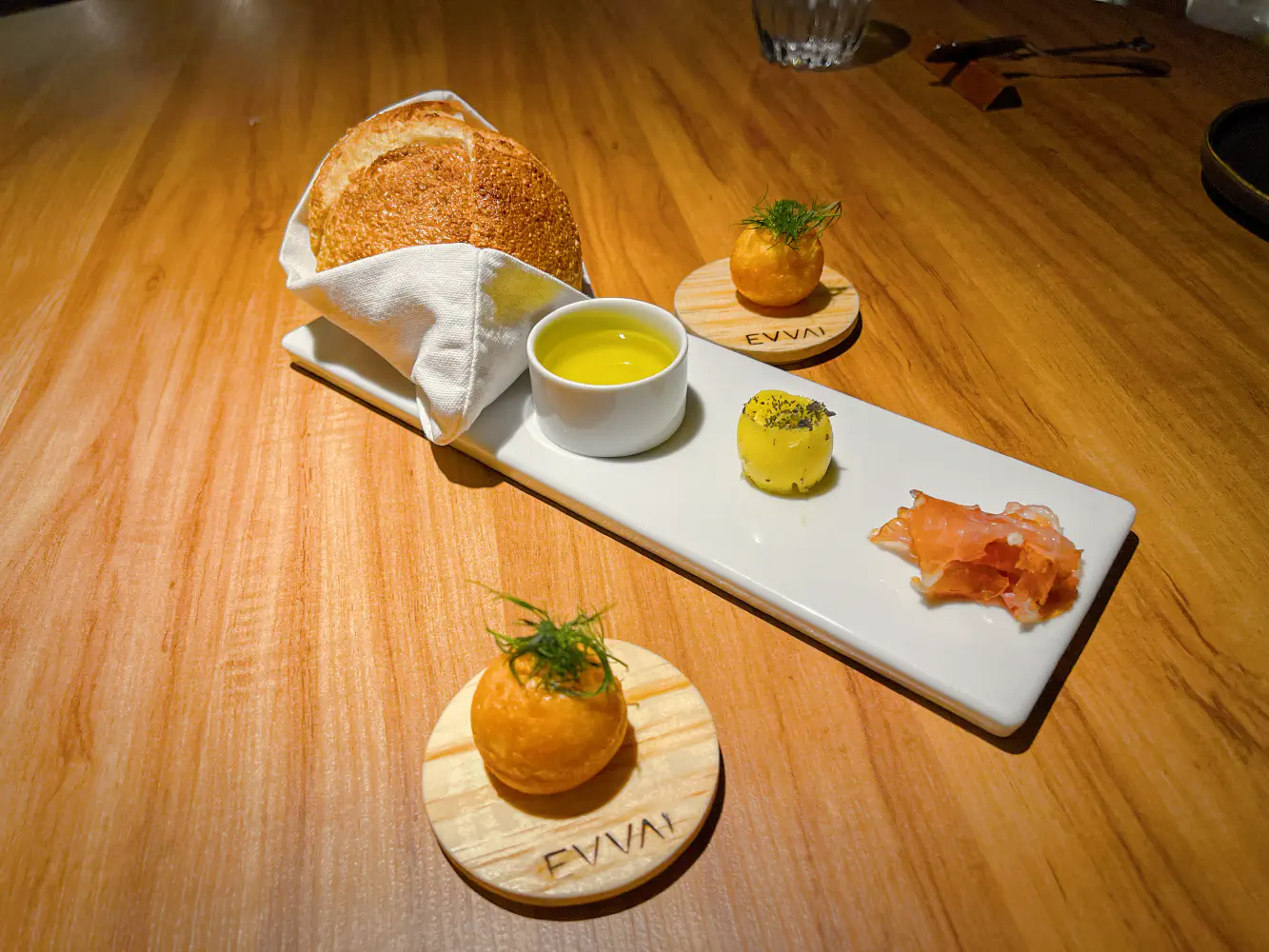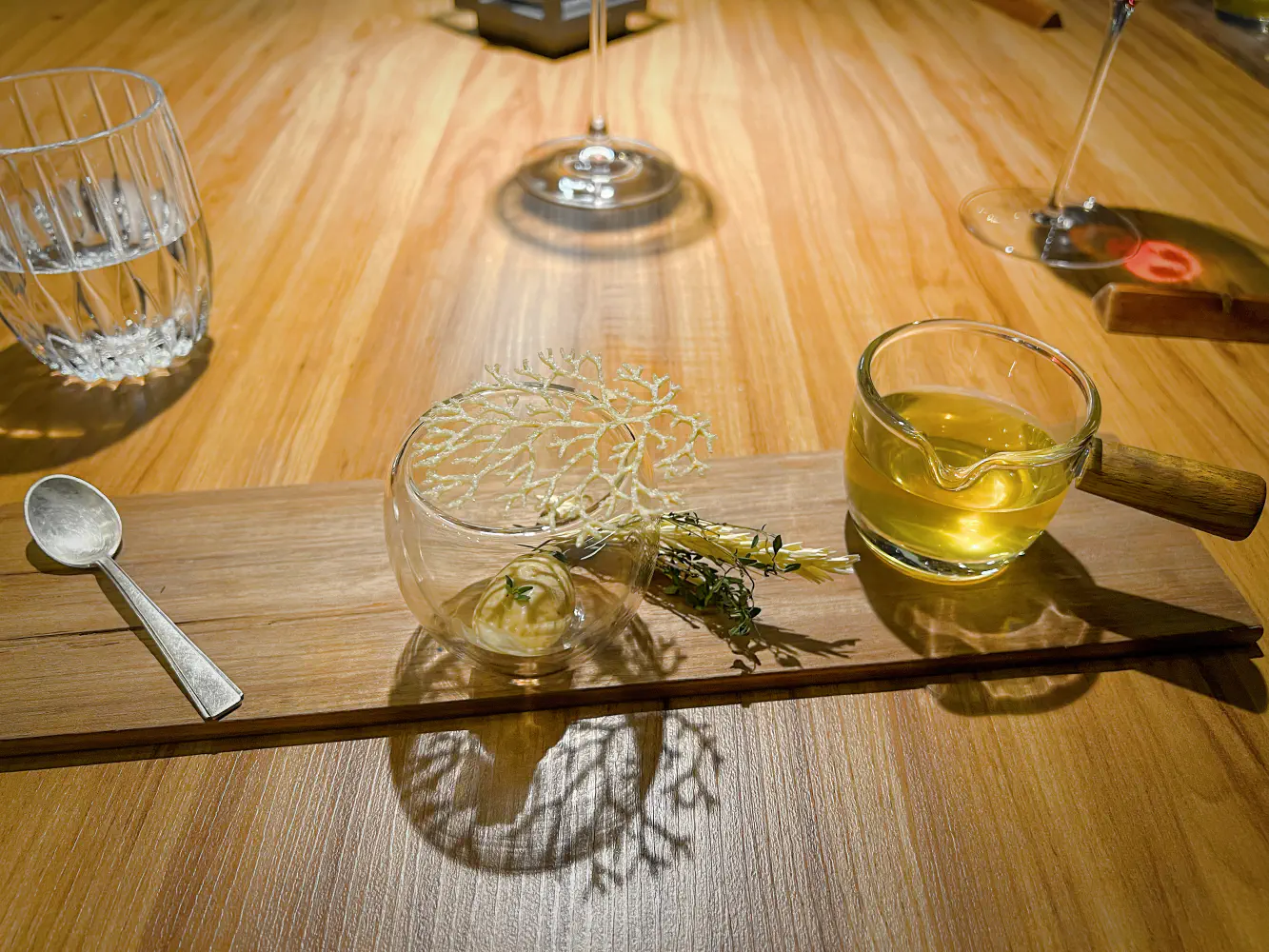Evvai

This is our first trip together to Brazil and São Paulo together. I’ve met many Brazilians at work, but I did not have any idea what to really expect out of the gourmand food scene. Unlike New York City, many of these Michelin Star restaurants were easier to get into. My partner chose this recently rewarded Michelin 2 star restaurant, Evvai, because it was known for showcasing Brazilian ingredients in a refine way.
Its recent accolades also include being awarded 22nd on World’s 50 Best Latin American Restaurants 2023.
Ambiance & Service
We arrived 5 minutes before our reservation, but we actually weren’t able to enter till about 10 minutes after. I was reminded that in Brazil things just move slower. It’s very common for things to not be on time, which might be bothersome for Americans like myself. My partner was a bit anxious because we’d have to sit outside and the fear of motorcycles causes a lot of concerns for them. Nonetheless, the restaurant did open, if not some minutes late.
Upon entering, there is a very small lounge area with sofas where the host asks you to wait and provides the menu for you to take a look and consider supplements. We were seated at the front table overlooking the kitchen. The room and seating decor was setup in such a way where it didn’t feel stuffy, and there was plenty of distance between tables. The music reminded me a little of Blanca and Smyth in that it was not too loud, but definitely chill, modern type music.
A note to all the prices is I’ve listed them in Brazilian currency (Real). At the time of purchase, the ratio was 1 USD to 5.4 Reals. Basically, take the price listed, and divide by 5.4, and that’s what the USD equivalency is.
The Oriundi Menu was R$799. The bump of Ossetra Caviar (5g) was R$199. The Plentitude Harmonizing pairing was R$837, which included wines from both Brazil and other worlds. It was described as the combination of the Magna pairing (R$1497) and Tune pairing (R$619).
As a FYI, I believe the tip (gorjeta) was included, and the water costs extra per bottle. This is normal in Brazil since many restaurants do not serve tap due to health risks.
Food
- Manioc Bread
- First Pairing
- Canapes
- Second Pairing
- Pumpkin Salad
- Third Pairing
- Curraleiro-Pé-Duro
- Fourth Pairing
- Pupunha Palm Tree Linguini
- Fifth Pairing
- Fish
- Sixth Pairing
- Raviolo
- Seventh Pairing
- Affo-Gato
- Eighth Pairing
- Little Piglet
- Carbonated Green Apple
- Ninth and Final Pairing
- Coco-Uliflower
- Croissant With Melipona Honey
- Candies
- Take Home

The Manioc Bread is made of cassava and came with olive oil from Serra de Montequeira (Mantiqueira Mountains in Minas Gerais), passion fruit butter, prosciutto made in Serra da Bocaina in Sao Paulo, and pão de queijo (Brazilian cheese bread) made from cheese in Araxá (pronounced “ah-ra-sha”), Minas Gerais. The manioc bread was fantastic. If you’ve never had cassava, it has a subtle dusty texture with a mild, nutty, and subtly sweet flavor. The passion fruit butter was simply amazing. I’ve never had this before, and I love passion fruit. It works surprisingly well together. The prosciutto was similar to others out there. Lastly, the cheese bread was one of the best I’ve ever had. I felt the Araxá cheese had a bolder flavor to it than other Brazilian cheeses.

The first pairing was port wine mixed with tonic, and a slice of citrus. At first it was harsh, but after the ice melted, it actually reminded me of spiked lemonade.

In the blurry background of this picture, you can see a set of post cards that describe each dish moving forward. Each time you are about to eat a course, you can take the front card and read the back about the origin of the dish. Very nice touch!
The canapes included the following:
- Acaraje Meringata - this is a traditional sweet snack from Salvador. This is made of black bean fritters.
- Bluefin Tuna Bomb - the blue color is from seaweed. It also has bluefin tuna and bottarga (cured fish eggs).
- Colatura Scallop Bomb - in the chef’s hand, this was made with fennel, tomato, and a kind of pork.
- Ilha do Marajo Cheese - cheese from Minais Gerais.
All of these bites were bold in flavor and really good.

The second pairing was a white wine riesling from Koehler-Rpurecht Kallstadter, Kabinett Trocken, 2021. This one was definitely full of minerals and noticeable sweetness.

The Pumpkin Salad came with alcoholic vinaigrette and tomato sorbet. The alcohol in the vinaigrette wasn’t very potent, so it was fine to eat. The salad greens itself were super crisp, light, and fresh.

The third pairing came from Domaine Parigot, Chassagne-Montrachet 1er cru ‘Clos Saint-Jean’, 2014. This wine came from France and had a delicious, buttery aftertaste.

The Curraleiro-pé-duro was a meat, sea granita, and beetroot. The left side is a tartare of a Brazilian breed of cattle that was brought over by the Portuguese when they arrived in Brazil. This breed has been able to endure harsh conditions since the origin. I recall the meat tasting very decadent, juicy, and quite flavorful compared to some of the American cattle. On the right side, it was a mix of oyster and beetroot roasted in cocoa nibs. This reminded me of oysters being flash frozen and shattered into little specks.

The fourth pairing was a Brazilian white wine from Leone Di Venezia ‘Garganega’, Santa Catarina, 2021. This had high minerality and high acidity. It was not one of my favorites, but I was pleasantly surprised by how drinkable this was.

The Pupunha Palm Tree Linguini came with squid and alle vongole. For the noodles, they combined both cold linguini pasta and confit squid. It was seasoned with sharp acidity, white wine, and parsley oil. We also added a caviar “bump” (+R$199), so they put it on top of this. This was actually a perfect complement, and I’m glad they did not give us caviar by itself.

The fifth pairing was Era dos Ventos Peverella Licoroso, Serra Gaucha, 2018. This is another Brazilian wine. This was an orange sparkling wine that had a lot of complexity to it. I really enjoyed this.

The Fish came with cupuaçu (pronunced “ku-pu-ah-su”) and jambu. The cream on the side was the cupuaçu, which reminds me a little of a citrus passion fruit meets melon flavor. It was sublime. In the background is a plant that has a little butterfly, made of jambu. Jambu is a flower that gives it a numbing, tingling sensation. The sauce reminded me of a Japanese miso-style broth, and the fish was absolutely phenomenal. Everything here was really good.

The sixth pairing was Brunello di Montalcino, Tenuta di Sesta, 2017. This was a delicious red wine from Italy, that has balanced acidity, tannins, and was dry.

The Raviolo came with guinea fowl and tucupi. The broth is made from tucupi, which is a yellow sauce extracted from a wild manioc root from the Amazon. This was pretty good because the fowl was tender and had some interesting flavors to it. There was mushrooms in it, but the flavor was mild.

The seventh pairing was Zanotto from Reserva Tannat, Serra Gaucha, Brazil, 2020. This was a dry, red wine that tasted pretty complex and definitely finishes with a burst of tannins. You can tell somewhat by how dark the wine is as well.

The Affo-Gato was Santa Catarina porcini mushroom ice cream with guinea fowl broth. I was probably in a hell, but the broth had lots of strong truffle flavors to it. My partner could not finish theirs, but my appetite for truffles outweighed the porcini mushrooms. The flavor, once the ice cream melted with the broth, resembled a meaty broth with some noticeable truffle tastes and some very light mushroom flavors.

The eighth pairing was the Audarya, Monica di Sardegna, Italy, 2021. You can tell the meat course was coming soon. This wine was actually pretty good on the tip.

The Little Piglet came with “green feijoada”, which in this case was fresh string beans. The sauce was very pleasant. The pork was absolutely delicious. The skin was extra crispy, and the meat was very decadent.

The Carbonated Green Apple came next with cucumber and sheep’s yogurt. This meant to serve as a palette cleanser. Everything is natural here, and the tart and freshness of the ingredients was to reset your palette for the dessert.

The ninth and final pairing was this Ron Zacapa Centenario “Sistema Solara” no.23. This was a rum that has a balanced spicy touch of cinnamon and ginger.

The Coco-uliflower came with coconut, cauliflower, and white corn chocolate. This was very forward coconut flavors along with corn. My partner enjoyed this a lot.

The Croissant with Melipona Honey was the final dessert. They rolled a cart around, and the server pours a lot of honey on top of a croissant and what appears to be a frozen popsicle. I didn’t record the audio for this, so I don’t remember what this was.

The candies in the front row (left to right):
- Chocolate with raspberry and pistachio
- Dulce de leite
- Orange Macaron
The candies in the back row (left to right):
- Spicy Candy
- Homemade gummy gears made with bacuri fruit, which is found in Northern region of Brazil.
These were all pretty good. The spicy candy had a very strong kick to it. The gummi bears were delicious.

The take home item was a caramel bar. This reminded me of a Hershey’s but with a lot of caramel flavors. Not exactly my ideal choice, but it was cool to have some candy.
Overall Impression
Evvai was surprisingly very delicious and had an excellent wine pairing to boot. You can ask for an English menu and English speaker, though some of it comes across a little broken. Nonetheless, the food was different enough from anything that I had, and the ambiance felt up there. Definitely check this restaurant out if you’re into Brazilian flavors executed with finesse.
Yelp Jabs
Because there aren’t many Yelp reviews for this restaurant due to Yelp being unpopular in Brazil, we’ll take a look at Google Reviews instead.
After all, I spent more than 2500 reais on dinner and left hungry.
Maybe this person had a monstrous appetite, but I definitely felt full at the end.
I still can’t believe this place is Michelin recommended. It must be political, I don’t know.
This restaurant, compared to NYC standards, definitely deserves its two stars.
Revisions
- Jun 14, 2024 - Initial revision.